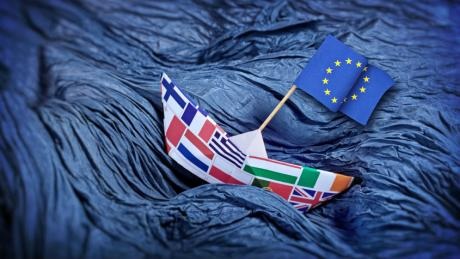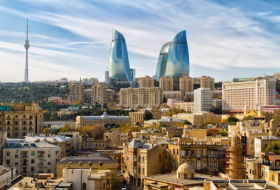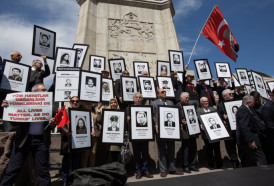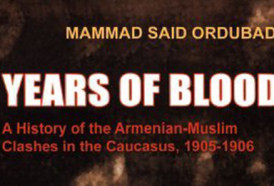The states have different national interests and compete with each other. In conflict situations most of states prefer to use tools of coercion, rather than consent. Nevertheless, European experience is an example of peaceful conflict resolution through regional integration process, i. e. so-called “merger”. France-Germany hatred was an issue of a long national identity conflict, especially after World War II and Saar Protectorate. However, these two countries could overcome mutual hatred and cooperate through integration process that contributed to Saar conflict resolution. Trade and economic cooperation was successfully used as a peace-building vehicle between two countries.
European politicians and authors promote the “exportation” of European integration model abroad and suggest that integration potential between Azerbaijan and Armenia could contribute to Nagorno-Karabakh conflict resolution. Moreover, they argue that the conditions of potential integration process in South Caucasus are the same as were at the beginning of European integration. Thus, the question of the possibility of such integration as a tool of conflict resolution arises and needs to be analysed.
Experience of European Integration
Neo-functionalist, Ernst B. Haas in his book “The Uniting of Europe: Political, Social, and Economic Forces, 1950-1957” suggests that when there is nothing more the government can give to societal actors, societies decide to rely on supranational institutions to satisfy their demands (2004). The French and German elites exhausted all the vehicles of economic development. This depletion urged them to step forward of creating supranational bodies that would minimize the economic costs and establish new market opportunities.
In addition, such external factors as growing Soviet Union threat pushed elites to speed the integration process for peacekeeping and security enforcement in the region. Integration process between two countries also contributed to resolution of Saar Protectorate conflict that was a stumbling block. Saar issue yet more poured oil on hatred flames of Franco-German relations. Although the primary goal of integration process was not Saar conflict resolution, however, this rub was successfully put out through the process.
The idea of European collective identity was based on three pillars:
- Christianity;
- Democracy;
- Social market economy (Marcussen, Risse, Engelmann-Martin, Knopf, & Roscher, 2001).
Status of Saar
Saar, being border region between two countries, was a very rich territory of coalmines. Both countries claimed the annexation of the territory from mercantile intentions, though from constructivist perspective Germany had more right to the German-speaking territory of Saar. According to the Treaty of Paris in 1815 France lost the territory of Saar, however, made all attempts for the restitution. In 1919 at Paris Peace Conference after the First World War French government tried to return Saar again unsuccessfully.
Nevertheless, the success was achieved in Treaty of Versailles, according to which France gained “the rights to own and exploit coal mines” (M., 1949), while the exercise of sovereign rights was granted to “the society of Nations, acting through the Governing Commission” . After Adolf Hitler came to power the Saar habitants were apt to join Nazi Germany, what they did on May 1935. When the Second World War broke out, the Saar and Lorraine were consolidated that brought economic growth to the region because of “the mobilisation of Saar-Lorraine industries” (Lorraine is rich of ore) (M., 1949). In 1945 France could add Saar to French occupied zone in Germany.
After war ended, the Saarlanders wanted to reunify French and Saar economies. In 1947 the new constitution that provided for separation of Saar from German political control and annexation to France with the status of autonomy was adopted. Although Saar was culturally different from France and more close to German, the autonomous status of territory provided the respect for German culture there that did not interfere the economic growth of Saar. According to agreement of 1956 between France and Germany Saar was decided to become a state as Saarland of Federal Republic of German. However, France reserved its rights of benefitting from coalmines (result of establishment of ECSC). As a result, both countries could benefit from the region and reduce economic costs.
Economic Complementarity
Recalling the authors Oli Brown, Shaheen Rafi Khan and Faisal Haq Shaheen, “the EU’s genesis was a unique set of circumstances: the devastation of the EU’s productive capacity after the Second World War and the determination of its political leaders to banish any future prospect of war” (2009). Ability of German economy to fast recovery made French elites consider how to control and direct German economic development for French elites’ profit. Bringing two countries together could have served the interest of France.
At the same time, Germany could have easily returned its political position through integration process. Understanding of these circumstances made countries reconsider political relations and agree on economic cooperation as the first pace of rapprochement. Economic complementarity of French coal and German steel made possible converge two markets into more profitable and united one. Elites in France and Germany understood that the economic cooperation could minimize the costs of parties, maximizing absolute gains (Stefanova, 2006). They pushed two governments to establish cooperation in spite of the mutual everlasting hatred of these countries.
European Coal and Steel Community (ECSC) brought the economies of European countries together, creating a common market. As Pierre Uri, chief economic analyst for ECSC wrote in his book “Ce qui se réalise”: “The effort contrasting sector integration with general economic integration is a vain one. The common market for coal and steel by itself contributes decisively to the producers and consumers of coal and steel. But at the same time it offers the opportunity for stating and effectively solving the problems of creating an integrated European economy suitable to the modern world.” (Haas, 2004).
Social Cohesion
Social cohesion plays a key role in regional integration. It is composed of different variables that link the region, such as religion, culture, language, alphabet, common history and common heritage, ethnic and national identity issues.
The identity is not only endogenous, but also exogenous. It is a socially constructed phenomenon that can be reconstructed if majority is willing to. Haas argues that in regional integration the phenomenon of national identity should be dismissed (2004), although the national identity differences between these two actors had very deep conflicting roots. Some authors suggest that the party elites play an important role in going away from nation state identity to collective identity (Marcussen, Risse, Engelmann-Martin, Knopf, & Roscher, 2001).
The European experience is an evidential fact of the identity reconstruction. The political elites in both countries were interested in creating such collective identity, in order to maximize their economic gains. They introduced the idea of “European Family” that had common history, traditions, the same religion, alphabet and similar languages. Cultural similarities of these two countries contributed to their rapprochement. Both profess Christianity that was one of the pillars of European collective identity. Moreover, the alphabet and language of both countries are based on Latin ones that facilitated the interaction between populations and precipitated the integration process. The important role in European integration process played democratic values as well. The focus of integration potential was put on these similar liberal ideas of Greek-humanist and Roman-legal values (Haas, 2004).
Managing the Internal and External Threats
Although European integration started with the idea of improving economy of the region, however, beyond steel and coal cooperation, the political intentions were placed: first of all, prevent any future war in the region (internal factor) and balance against external threat of Soviet Union (external factor). According to Schuman Plan, revived Germany should have been placed inside the “democracy of Europe” (1948).
Making Germany European could prevent any possibility of future war in the region and provide stability and security. The other concern of elites was to rally Europe against growing Soviet Union threat. Uniting the Europe could balance the Soviet Union threat and create very strong and strategic ally of USA in the Europe. That’s why this integration was so highly encouraged by American authorities through Marshal Plan of providing economic support for Europe to rebuild it and prevent further spread of communist ideas.
Integration Potential between Azerbaijan and Armenia
The integration potential between Azerbaijan and Armenia is questionable and lacks the economic, social and political capacity. South Caucasus possesses very weak regional characteristics. Region is assumed to have “a limited member of states linked together by a geographic relationship and degree of mutual interdependence” (Abushov, 2011). Thus, region implies geographic proximity with regular interaction, creating ethnic and cultural similarity, the similar level of economic development and security economic interdependence.
Some authors argue that integration potential is almost unlikely among less-developed countries. As Hansen mentioned, it produces more problems rather than peaceful coexistence (2006). The different level of economic growth deters the integration process. The states seek to gain more, and cannot distribute equally the profit, resulting in even more discontent. Those countries with relatively high capacities in the region would take dominance “intensifying regional hierarchy”. Both Armenia and Azerbaijan are not among highly developed countries. However, the level of economic growth differs across countries. While Azerbaijan performs very well in GDP growth for the last 4 years (about 4.7%), GDP growth rate of Armenia for the last 4 years almost equals to 0% . Integration potential for countries with different level of economic growth would be worthless and unfavourable.
Moreover, from the economic interdependence perspectives, there is no economic complementarity of goods between Azerbaijan and Armenia. Some authors argue that Azerbaijan has natural resources, like oil and gas that could be economic incentives for integration potential. However, there would have been no goods for Azerbaijan to benefit in return. It could return Nagorno-Karabakh territory, but the game would not be worth the candle. Armenians have destroyed the fertility of the Nagorno-Karabakh land. All towns and villages have been burned; gold miners have been filled up with sand. Azerbaijan would have to spend a lot of means to restore NK territory. The recovery price would be very painful both for economy and foreign policy of Azerbaijan.
One could argue that Armenia could provide the transit space for oil pipelines. However, Azerbaijani economic cost for transit through Georgia is much less than constructing new pipelines through Armenian territory.
The other feature of regionalism that contributes to integration potential is the regularity of interaction between countries that implies the language, alphabet, cultural similarities, ethnic diversity, religion and common history and heritage. Azerbaijan and Armenia have absolutely different languages and alphabet that complicate the interaction process. Moreover, there is significant difference in religion. While Azerbaijan is over 92% Muslim, Armenia is over 99% Gregorian Orthodox.
Although Armenians and Azerbaijanis lived peacefully together in Soviet Union, the possibility of future peaceful coexistence is almost unthinkable. There is so much hatred and abhorrence between the nations that none of sides could forget the dark bloody pages of history. According to the Armenian-Azeri Mutual Perception project research conducted by Azerbaijani Sociological Association, 66.8% of Azeri respondents answered that even if Armenia had returned Nagorno-Karabakh territory, the establishment of peace between Azerbaijan and Armenia would have been impossible (2003). The history of conflict is so bloody that it is impossible to forget the cruelties and live in peace afterwards.
Integration potential lack the political incentives as well. The main distinction is in different foreign policy orientation. While foreign policy of Armenia is pro-Russian oriented, Azerbaijan possesses sovereign and neutral foreign policy orientation. In light of these obstacles the negotiation process of integration would be nearly impossible.
The other integration potential factor of no small importance is an external threat stimulus. Integration potential in region misses such stimulus and therefore region itself is too small to form an alliance that would balance external threat.
Can Regional Integration become a solution?
The regional integration between Azerbaijan and Armenia could not be treated as a doable solution of Nagorno-Karabakh conflict like it was done by European integration experience. The conditions of integration distinguish considerably from European one.
Compared to Saarland conflict, Karabakh is bleeding and dissolves in tears of civil losses. In Saarland population never fought each other. German-speaking population was not discriminated, living in peace and prosperity, while Armenians oppressed Azeri minority groups violently and consistently.
Moreover, Saarland claim was driven by economic interest in coalmines, whereas Karabakh was the ethnic conflict that emerged after the collapse of Soviet Union. Saarlanders were interested in economic cooperation with France because of the possibility of gaining more and reducing the economic costs. However, NK conflict pursued political aims.
Unlike the complementarity of German steel and French coal, the economic incentive is absent in Azerbaijan-Armenia relations. Whereas France and Germany reciprocally and equally benefited from such integration experience, in Azerbaijan-Armenian case one side would gain more, especially Armenia, and the other side, Azerbaijan, would suffer huge economic loss.
Moreover, compared to Azerbaijani-Armenian case, Germany was a defeated country and it saw the integration potential as an only way of survival. One could argue that in Nagorno-Karabakh issue Azerbaijan should be perceived as a defeated party. However, the case events demonstrate the opposites. Azerbaijani people have indisputable rights on Nagorno-Karabakh territory and aren’t loosing party.
The conditions of European integration experience and Azerbaijani-Armenian integration potential differ in social aspect as well. While, as De Rougemont mentioned, the integration process in Europe would save the common European “Christian-spiritual values” (2004), Azerbaijan and Armenia don’t have similar religious and cultural values that could bring two nations together and overcome the black spots of relations. The values of Islam and Gregorian Orthodox vary completely.
Compared to European integration where the capacity of rapid recovery of German economy had to be controlled, the South Caucasus region does not have such internal threat stimulus. The last and very important distinction between these two integrations is differences in foreign policy orientation. While France and Germany possessed the same foreign policy orientation and saw the Soviet Union and communist ideas as a main external threat to national interest of states, Azerbaijan and Armenia have different foreign policies.
To sum up, the European integration experience was a unique example of merger of political, economic and social interests that brought this phenomenon into existence. The conditions of integration potential in South Caucasus differ dramatically in roots leaving no space for consideration of such capacity. The main aspects of European integration experience such as economic complementarity of goods, social cohesion, external threat and internal factors are absent and differ from Azerbaijani-Armenian one. To regard the integration potential as a solution for NK conflict resolution is aberrational and should be dismissed.

Ulkar Panahzade
Candidate for Master in Arts of Diplomacy and International Affairs, ADA University
















































